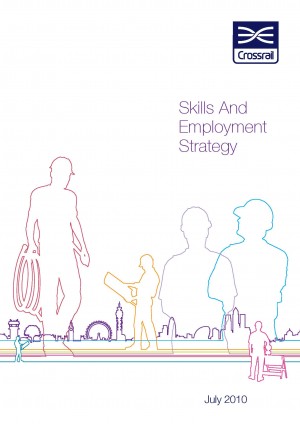
Crossrail Skills & Employment Strategy
Document
type: Micro-report
Author:
Nathan Pascutto
Publication
Date: 27/09/2016
-
Abstract
Crossrail had the opportunity to have a significant impact on the skills and employment across London and the South East.
This micro-report explains the main considerations which shaped Crossrail’s development of its Skills and Employment Strategy, and then describes Crossrail’s experience of implementing this Strategy. This report supports other micro reports and case studies within the Talent & Resources Learning legacy theme.
This report will be of interest to HR directors; organisational development practitioners; learning & development practitioners; employee relations specialists; individuals with an interest in engagement/education programmes leading to increase skill or employment outcomes.
-
Read the full document
Introduction & Industry Context
Crossrail is Europe’s largest infrastructure project. It required the mobilisation of a highly skilled workforce to ensure that the project is delivered safely, on time, and within budget.
In 2014, the construction and engineering sectors employed over 2.1 million people across the UK. [1] Combined, these sectors accounted for 6.5% of the UK’s Gross Domestic Product in 2014, signifying the importance of the construction and engineering sectors to the UK economy. [2]
In recent years, the construction industry has faced a decline in output. However, both construction and engineering remain critical to the competitiveness of the British economy. Maintaining skills and developing the next generation are crucial to the UK’s ongoing competitiveness and productivity. Inspiring and training the next generation of engineers and construction workers may continue to be a challenge, but because of the timescales involved in large construction and engineering projects such as Crossrail, it is vital. Projects being planned now will be staffed by people who are currently in school or college or retraining from other sectors or other parts of the construction industry.
This report focuses on the development and implementation of the Crossrail Skills and Employment Strategy.
The Case for Skills
Having the right people with the right skills at the right time was critical for the safe, on time and on budget delivery of the Crossrail project. For Crossrail, the case for identifying and engaging the appropriate skills encompassed three key features relating to safety, social and political aspects.
Safety Case
Crossrail committed to up-skilling people and embedding a strong safety culture across the supply chain. By having a suitably skilled workforce, Crossrail was able to drive improvements in both safety performance and productivity and make it clear that safety was the foundation of Crossrail’s delivery.
Social Case
The Elizabeth Line route traverses areas of London and the South East, and in particular through some areas with a low socio economic profile. As a publicly funded project, Crossrail had an obligation to ensure that the wider issues of economic development, sustainability and social development were considered and acted upon. Although the picture was not uniform across London and the South East, many areas had a low skills base which needed to be up-skilled to build a higher skilled pool of local labour which could be employed on the Crossrail project.
As part of the Crossrail Act 2008, Crossrail Limited was given two Parliamentary commitments in regards to local labour and training:
- Equality of opportunity for business and UK citizens
- Recruitment of local businesses and people around Crossrail construction sites and stations
Political Case
Throughout Crossrail’s construction there has been Parliamentary support for the skills agenda and encouraging employers to invest in a skilled workforce. The government placed an emphasis on the importance on placing employers at the forefront of skills design and delivery, through programmes such as the Employer Ownership of Skills Programme, and the reformed Apprenticeship programme.
Crossrail Skills & Employment Strategy
Although Crossrail is Europe’s largest infrastructure project, it is not immune to skills and employment challenges. As a large engineering project, Crossrail was presented with some unique challenges, particularly in relation to the skills required for tunnelling. Crossrail’s Skills and Employment Strategy set out how Crossrail would best generate the skills and resources required to deliver the Crossrail project, how it would inspire future talent, and leave a lasting skills legacy to the industry.
The Skills and Employment Strategy focused on providing local people with the opportunity to work on the project, and to ensure it had the skills it required to deliver now and into the future. It did this in a number of different ways:
- Partnership with JobCentre Plus
- Establishment of the Tunnelling and Underground Construction Agency (TUCA)
- Establishment of a major apprenticeship programme
- Establishment of the Young Crossrail Programme
Determining Project Workforce Requirement
In 2009, Crossrail commissioned a skills and labour forecasting exercise to identify the workforce that would be required to deliver the Crossrail project. Using a specialist consultancy, Crossrail set out to identify the required workforce and any skills gaps which could affect the safe and on time delivery of the Crossrail project.
The workforce profile was determined by consulting with Crossrail contractors on their anticipated labour needs and benchmarking these against recent major construction projects, such as the London 2012 Olympics. The output from the analysis was divided into 31 distinct job types across three different themes of management, engineering, and craft trades and provided a skills and labour estimate of the workforce required.Figure 1 – Total Workforce — Crossrail Labour Needs Analysis, 2009 [3]
Figure 2 – Craft Workforce Required by Skills — Crossrail Labour Needs Analysis, 2009 [3]
As part of the exercise an analysis of Greater London’s labour supply was undertaken in order to gauge readiness to meet Crossrail peak demand for specific trades. To perform this supply side analysis, data was obtained from the Skills Funding Agency (SFA), to determine the certification achievement within the further education sector and the future labour supply pipeline. The information from the SFA was supported with information from other sources including sector trade organisations (e.g. Engineering UK, British Tunnelling Society); government/executive agencies (e.g. Office for National Statistics, UK Commission for Employment and Skills); academic institutions (e.g. London School of Economics); industry training boards (e.g. Construction Industry Training Board); and Sector Skills Councils (e.g. The Science, Engineering, Manufacturing and Technologies Aliance ).
The Skills and Labour forecasting exercise identified the following headlines for the Crossrail project:
- Crossrail could create up to 70,000 jobs over the lifetime of the programme. This was revised to 55,000 in 2014
- At the peak, around 15,000 could be working on the Crossrail project with up to 3,500 working underground. This was revised to 10,000 in 2014
- At the peak, over 1,000 training opportunities per annum were identified
- Shortages in highly-skilled trades had the potential to affect safety, quality, cost and programme schedule
- The labour supply of tunnellers was insufficient the to support the Crossrail works
Crossrail’s skills and labour forecasting was updated throughout the Crossrail project to take into account updates to cost and programme schedule, as well labour market supply conditions. This ensured that the labour market forecasting data was able to inform the Skills and Employment Strategy and action plans.
Skills Issues – Crossrail Context
Taking into account the workforce needs and supply analysis, Crossrail identified five key issues which could affect the successful delivery of the Crossrail project:
- An ageing workforce in the construction and engineering sectors which is not seen as an attractive career option for young people
- Skills gaps within the construction and engineering sectors with demand outstripping supply
- Underground construction skills gaps as a result of past peaks and troughs of work
- Logistics training needs for lorry drivers to allow them to safely carry out their role, including cycle awareness
- Economic outlook of the UK economy, including the competitiveness and productivity of the construction and engineering sectors.
Skills & Employment Strategy Objectives
Considering the skills issues which were relevant to the safe, on time and within funding delivery of the Crossrail project, Crossrail’s Skill and Employment Strategy focused on four key objectives, which are outlined in the Table below. The objectives were chosen as they were considered to potentially have the greatest impact on the Crossrail project and satisfied Crossrail’s Parliamentary commitment on local labour and training.
Objective Priority Maintaining Safety To mainstream safety and ensure that it is at the heart of all aspects of work
- Ensuring that safety modules are included in all training, where relevant, from induction onwards
- Make sure incidents are reported, investigated ad communicated
- Promote site safety through certification
- Provide occupational health and hygiene provision
- Provide hazard awareness training and desktop scenarios
- Provide driver training
- Maintain Health & Safety training
Inspiring Future Talent To motivate young people to pursue careers in construction and engineering
- Continue the Young Crossrail Programme
- Facilitate work placements
- Facilitate graduate work placements
- Offer industry updating for teachers/educators
- Provide 400 Apprenticeships
Supporting Local Labour To develop the skills of local people to gain employment within the Crossrail Programme
- Facilitate job and skills brokerage
- Require contractors to sign the Crossrail Skills Pledge and provide a formal training plan
Revitalising the Skills Base To promote the benefits of building a Tunnelling and Underground Construction Academy for the industry
- Work in partnership with the supply chain
- Design and build TUCA
- Develop and deliver the curriculum
- Provide a skills legacy
Figure 3 – Skills and Employment Strategy Objectives
Implementing Crossrail’s Skills & Employment Initiatives
Crossrail, working with its Partners, (the Programme Delivery Partner & the Project Partner), and supply chain, worked to implement the initiatives which were outlined in the Employment & Skills Strategy. The Strategy was communicated across the Crossrail project through various communication channels such as Connect in Brief updates, the On Site newspaper, and tool box talks.
Achievements and successes are celebrated annually through the Crossrail Apprentice Awards and the Crossrail Sustainability Awards. This assisted in raising the profile of the Skills and Employment Strategy as well as the achievement of Crossrail, its Partners and the supply chain.
Further information on the implementation of these initiatives is available in the following learning legacy documents:
- Apprenticeships
- Addressing Skills Gaps though Direct Intervention (TUCA)
- Social Sustainability Working Group Terms of Reference
- Young Crossrail Programme
- Corporate Work Experience
- Achieving Social Sustainability Objectives through Performance Assurance
- Implementing Contractual Skills and Employment Targets
Governance
The Talent and Resources Director was responsible for the implementation and the oversight of the Skills and Employment Strategy, with the support of the Crossrail Executive and Investment Committee and Crossrail Board.
A Skills and Employment Committee was established to advise and oversee the delivery of the Strategy and to ensure that Crossrail, as an organisation, was working to achieve the Skills & Employment Strategy’s four key objectives and priorities.
The Committee was resourced with expertise, with the membership including representatives from the Greater London Authority, London Development Agency, Job CentrePlus, the Skills Funding Agency, National Apprenticeship Service and ConstructionSkills (now the Construction Industry Training Board), and the Crossrail supply chain. This ensured that the committee was able to take account of the views and experiences from across the sector.
The Skills and Employment Committee continued to operate until 2012, when it was replaced by the Sustainability Committee. At this point it was considered that the Skills and Employment Strategy was firmly embedded across the project and that the Sustainability Committee offered the opportunity for the Skills and Employment Strategy to be considered alongside Crossrail’s other sustainability initiatives.
Measuring Progress
Progress against the Skills and Employment Strategy is regularly measured and reported to the Executive and Investment Committee; and the Sustainability Committee. At the time of publication (September 2016) key skills and employment outcomes of the Crossrail project included:
- Over 600 apprentices against an original project target of 400
- Over 16,000 training starts at the Tunnelling and Underground Construction Academy since opening in September 2011
- 28% of women on the integrated project team with an average of 9% of women on site over the last three years, with a successful partnership established with Women into Construction
- Establishment of the Crossrail Job Brokerage which directly secured employment for more than 700 local or previously unemployed people between 2011 and March 2016
- Engagement with over 44,000 students, parents and teacher through the Young Crossrail Programme with the help of over 280 Young Crossrail volunteer ambassadors
- Over 400 work experience placements though the Young Crossrail Work Experience Programme
- Over 70 graduates have completed the Crossrail Graduate Programme since 2012
Lessons Learned
- Building a case for skills within the organisation assists in identifying employment objectives and priorities
- Skills and employment strategies should be underpinned by robust labour/skills needs analysis which is updated to reflect programme changes and emerging labour market and macro economic indicators
- Effective engagement with partner organisations and the supply chain is important in ensuring that skills and employment initiatives are implemented. Using contractor forums is a good way of maintaining momentum and focusing contractors on the delivery of initiatives
Recommendations for Future Projects
- Focus on a limited number of initiatives to ensure effective implementation. This will help focus the organisation and the supply chain
- Carefully consider how you measure progress. Make sure that you focus on qualitative indicators as well as quantitative and take the time to celebrate success
- Communication and engagement across the organisation and the supply chain is key to embedding skills and employment initiatives.
- Consider establishing a committee/forum which brings together contractors and experts to focus contractor’s efforts and share best practice.
References
[1] House of Commons Library, Construction Industry: Statistics and Policy, 2014
[2] Note 1
[3] Crossrail, Skills and Employment Strategy, 2010
-
Document Links
-
Authors
Nathan Pascutto
Nathan Pascutto was the Business and Policy Manager for Talent & Resources at Crossrail from 2014 until 2018. Prior to joining the Crossrail project, Nathan held senior policy positions across both the Australian and UK Governments, including the Department of Finance, and the Treasury in Australia; and the Department for Education; and the Department for Energy and Climate Change in the UK.
Nathan has a Bachelor of Business and a Bachelor of Laws from Southern Cross University, Australia, and a Graduate Diploma of Legal Practice from the Australian National University.



